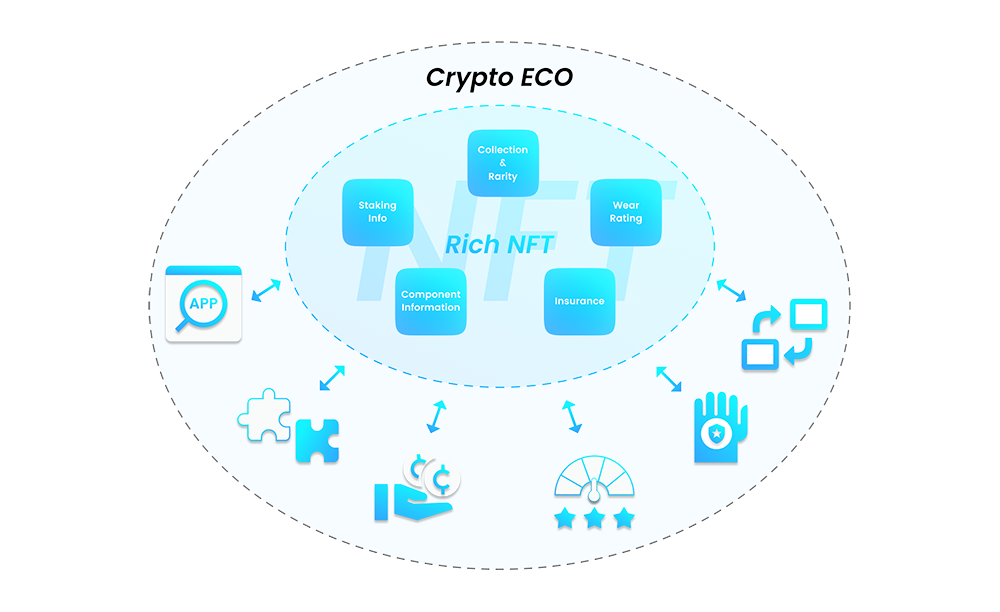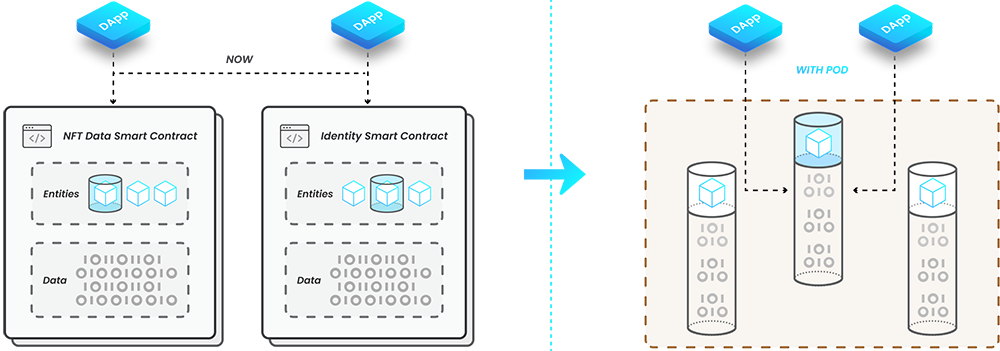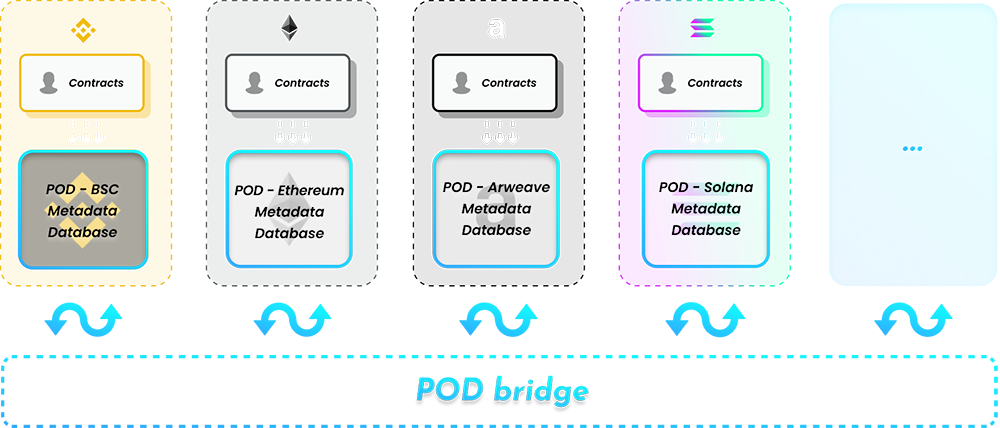In the past two years, the entire encryption ecosystem has ushered in leaps and bounds. However, the attention of all parties is mostly focused on the underlying public chain and business layer applications, and the attention paid to the middleware at the front and rear ends is relatively weak.
Nowadays, with the rise of DeFi, Metaverse, NFT, GameFi, and the entire encryption market, the requirements for data processing, storage, and transmission are getting higher and higher, and the demand and attention for middleware are also rising.
Recently, Odaily noticed aPOD (Public Onchain Database)middleware protocol. POD is an on-chain data middleware built across blockchain networks, mainly serving developers and projects by providing customized metadata management solutions as a searchable database in the Metaverse.POD is also the first Web3 data collaboration platform designed for the characteristics of metadata, and its vision is to promote the establishment of metadata collaboration consensus.
With the rise of a new round of Metaverse boom, middleware protocols that focus on data processing have begun to explode. In the fierce competition, where is POD going?
1. Web3 middleware POD rides the wind
When it comes to the underlying public chain and applications, most users in the encryption market are familiar with it, but they know little about middleware.
In traditional development, an operating system is usually divided into bottom layer, middle layer, and business layer. The bottom layer is the architecture (which can be compared to a public chain), and it is also the basis of data communication. The middle layer involves the service part that connects the upper and lower layers and provides two-way services. The top layer is the business layer (including various Dapps including Uniswap).
From a functional point of view, middleware services provide developers with more convenient operations, so that they do not need to repeatedly develop commonly used modules, and they can also use the services provided by these operators.
Specific to the encryption market,The middleware protocol allows developers to develop applications without spending energy on learning the underlying logic and knowledge of the public chain, and even without knowing the technology of the blockchain, thereby greatly reducing the threshold for accessing the blockchain. In particular, the cross-chain middleware protocol can deploy smart contracts on a visual interface through a unified API, which also forms the encapsulation and cognitive folding of blockchain technology.
For a long time, the middleware protocol track has been absent. There are two main reasons for this: first, encryption developers are mostly blockchain native developers, and there is little demand for middleware market; second, compared with more For applications that are easy to obtain traffic monetization in a short period of time, the middleware market scale and expectations are relatively small and there are no explosive models. The enthusiasm of all parties is not high, and the capital valuation is low.
However, all this has quietly changed in the past two years.
As Metaverse, GameFi, and NFT have become hot spots in the circle, various applications have sprung up like mushrooms, and the demand for data processing, storage, and transmission is increasing day by day, and the demand for middleware is getting higher and higher. Capital is moving on hearing the wind, and a number of top investment institutions, including Sequoia Capital, a16z, Alameda Research, Animoca Brands, etc., are also increasing their presence in the field of Web3 middleware, which is bound to promote it to become one of the biggest outlets in the market in the next few years.
As a rookie in the data collaboration middleware track, POD (Public Onchain Database) was officially launched recently and quickly gained market attention.As the first comprehensive metadata repository, from collaboration tools to robotics and automation, POD is creating a rich data ecosystem for Metaverse and Web3 users.
2. POD breaks down metadata collaboration barriers
In the past year, the concept of Metaverse became popular all over the world. Facebook changed its name"Meta", shifted the focus to the Metaverse space; Microsoft took the Metaverse as a strategic plan; Tencent continued to develop open world games; Bytedance acquired VR manufacturer Pico at a high price, and invested in the launch of the Metaverse game "Restart the World"; the crypto market chain game representative Axie Infinity has captured the Southeast Asian market and ignited the upsurge of chain games metaverse.
With the expansion of the metaverse, the challenges faced in the data processing process come one after another, as follows:
difficult to obtain: On-chain data is scattered among smart contracts in different networks, and it is not yet possible for contracts to obtain all data from a single common data environment; to access certain data elements, the system must establish point-to-point communication directly with the contract that stores it.
Difficult to associate: Due to non-relational storage, it is difficult to trace the relationship between two entities or link entities with their metadata. Therefore, it is a challenge to categorize and rationalize on-chain metadata.
Difficult to use: Each network or application is unique in how it transmits data, which means its APIs, data encoding methods, and access controls may not be compatible with others. Therefore, the process of data management and usage has not been automated. Data from different sources must be preprocessed to work together.
The biggest problem created by these challenges is that data processing, storage, and transmission all operate in an extremely inefficient manner. If things go on like this, the development of the encrypted metaverse is constrained, unable to compete with the centralized metaverse platform.
In order for metaverse scale and decentralized applications to function, a reliable third-party data collaboration platform is needed, and POD came into being.POD is a data middleware built on multiple blockchain networks on the Web3 chain for data collaboration, aiming to create a secure and trustworthy third-party data collaboration platform that allows developers, builders and users to Work with metadata more easily while managing all Metaverse data in a single interface, building a richer data ecosystem.

The so-called "metadata" refers to data that provides information about entities on the chain. In the blockchain world, users, assets, etc. are represented by on-chain entities that can identify a specific existence by its address or asset ID, such as an NFT or a contract, and the data that provides information about these entities is their metadata .
From the perspective of POD, data consumers in the Metaverse can include not only humans, but also programs, smart contracts, and physical machines (such as ticket machines). To ensure a smooth data collaboration experience, metadata should be structured and relevant so they are easily searchable and usable by people and software.
Based on the above ideas, POD designs an innovative method to store, organize, manage and use metadata on the chain, specifically from three aspects: entity-based metadata storage, metadata type definition, and cross-platform data consistency.
(1) Entity-based metadata storage.In POD, all metadata must be associated with entities on the chain, and POD brings a new method of data binding and distribution. As the carrier of metadata, tags are used to realize the non-transferable binding relationship between data and entities. That is, the user only needs to verify whether the entity has a label, and then can read the required data from the label, which will facilitate the verification and acquisition of entity data.
Also, within a POD, metadata can be in the form of values or logic. Values are deterministic, such as labels, certificates, descriptions, etc.; logic refers to programming logic that can get a value or store a value based on a given condition. For example, algorithms that calculate real-time reputation scores based on user status; or NFTs with lottery scripts for NFT components.

(2) Metadata type definition.A metadata type includes a set of rules about how to store a certain type of metadata element and a description of that metadata. It plays a key role in bringing together data from various sources and structuring them to support the required business logic. It can also be considered as an index of data, making it easy for users to find data, verify data, use data and manage data. The metadata type of POD mainly defines entities on the chain and stores metadata from three aspects: species, attributes, and relationships. For example, through POD, users can easily define and classify entities or concepts on the chain. Species can be validated by anyone, reused, edited and managed according to user-defined criteria.
(3) Cross-platform data consistency.The POD database consists of a series of contracts deployed on different blockchain networks. This design ensures a consistent data definition and a unified data structure at the bottom layer, so that the data in each network can achieve consistency. At the same time, these contracts are linked together through POD-Bridge, so one metadata type can be applied to data from different chains. In this way, data consistency across networks will be achieved, which is a prerequisite for users to process UGC (User Generated Content) level metadata using the toolchain provided by POD.

Therefore, with POD, all users can easily view and collaborate on the same category of data with the same understanding of the same entity or concept. In other words, POD provides an abstraction layer for the crypto community, allowing anyone to define abstractions and collaborate on the abstraction layer.
3. Real landing, looking forward to the future
At present, the entire Web3 middleware track has gradually exploded, and a large number of emerging projects have emerged, such as Arweave, Storj, Swarm, etc. Compared with these competing products, POD has six major advantages, summarized as follows:
Searchable:Users or smart contracts can store and query data on POD, and data can be classified and indexed on POD to realize potential collaboration possibilities.
can be defined:All objects on the blockchain can be uniformly classified and described through POD, which can provide network-wide class definition and attribute type definition capabilities.
customizable:When a user defines a certain type of data, the dataset owner can customize data management rules and ask POD to provide customized data service solutions.
Manageable:POD will provide various chain tools such as UGC tools and tag database system to support metadata management in various DApps or smart contracts such as GameFi, SocialFi, NFTFi and DeFi.
Unity:POD becomes a unified input and output port, breaks through the barriers between different applications, and establishes metadata standardization, industrialization, and segmentation.
flexibility:A flexible approach to metadata management on PODs will define and bind relationships between entities, NFTs and property values across Web3.
These characteristics also make POD favored by cooperative project parties. Odaily found that POD has cooperated with multiple projects such as DeHorizon, DDMeta, BlocWars, and Treasury Research, playing an important role in building data collaboration infrastructure for Web3 ecological applications such as GameFi, NFTFi, and SocialFi.
In the future, POD plans to launch a composable NFT protocol and POD DApp in the first quarter of this year; support multi-chain toolboxes in the second quarter; start the data bridge in the third quarter; and carry out POD ecological construction in the fourth quarter.
“Going forward, we hope to bring all parties together to establish a collaborative dialogue that incentivizes the decentralized community to agree on data collaboration standards in a bottom-up manner. This standard may include, but is not limited to, primary entity classes, commonly used metadata types, data storage solutions for different purposes, transmission interface design, etc. On the one hand, users can use this standard to seamlessly process data from any network. On the other hand, they can still freely adjust standard practices according to their business and needs. "For the future, POD has a clear plan.
With the subdivision of encrypted business scenarios and the development of distributed technology, more middleware and underlying public chains will continue to emerge. For POD, it is both an opportunity and a challenge, and we will continue to pay attention to the growth of POD.



